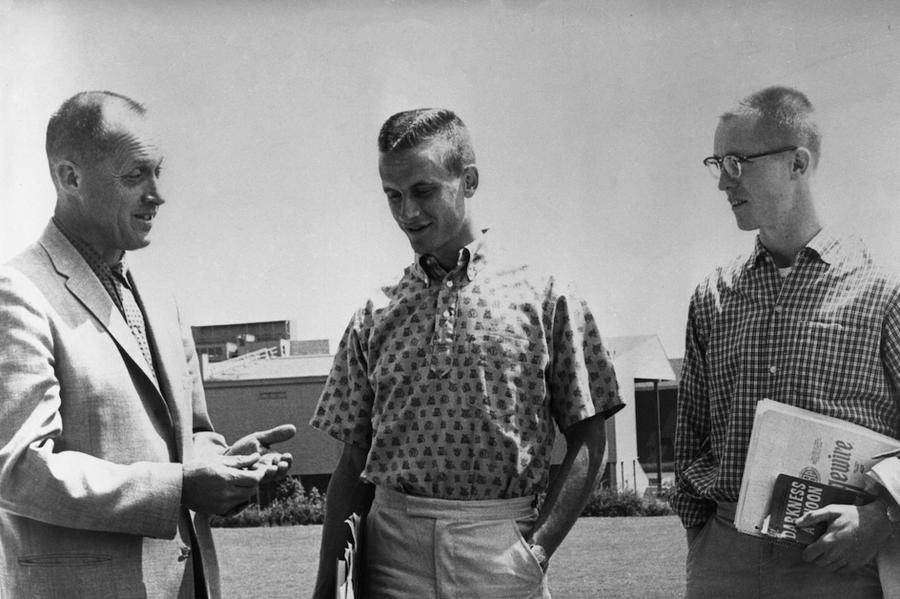What Was Bill Bowerman's Net Worth?
Bill Bowerman was an American track and field coach and entrepreneur who had a net worth of $400 million at the time of his death. Bill Bowerman is best known for co-founding Nike alongside Phil Knight. Bowerman was also the inventor of some of Nike's top-selling models, including the Cortez and the Waffle Racer. Bill himself assisted in company operations and helped Nike grow into the world-renowned name that it is today. Bowerman himself crafted shoes in his own home from a waffle maker in the kitchen. He passed away in December 1999.
Bill Bowerman's Wealth/Nike Equity
The day Nike went public in December 1980, Bill owned roughly 26 million shares of the company. By the end of the first trading day, those shares were worth $9 million. On the day of his death in 1999, Bowerman's stake was worth $390 million. If Bill were still alive today, his 26 million shares would be worth $3.5 billion.
Early Life
Bill Bowerman was born William Jay Bowerman on February 19, 1911, in Portland, Oregon. His father was the former Governor of Oregon, Jay Bowerman. His mother grew up in Fossil, Oregon. The family moved to Fossil after Bill's parents divorced in 1913. Bowerman had two older brothers and a sister. His twin brother, Thomas, died in a tragic elevator accident at the age of 2.
Bowerman attended schools in Medford and Seattle before returning to Medford to attend high school. He played in the high school band and was on the school's championship football team in his junior and senior years. It was in high school that Bowerman first met Barbara Young, who he would later marry.
College Years
Bowerman attended the University of Oregon in 1929, where he played on the football team and studied journalism.
Most importantly, Bowerman joined the college track team, which would launch his lifelong relationship with the sport. He was also a member of the Beta Theta Pi Fraternity.
After Bowerman graduated college, he taught biology and coached football for Franklin High School in Portland, Oregon. He started this position in 1934. However, in 1935, Bill moved back to Medford in order to teach as well as coach football.
He helped the team win a state title in 1940. Bowerman had to put his coaching and teaching career on hold in order to take part in the ROTC and Army Reserve following the infamous Pearl Harbor attack that propelled the US into WW2. He would go on to join the United States Army, reaching the rank of 2nd Lieutenant.

Bill Bowerman(left), Dyrol Burleson(center), and George Larson(right) (Photo by Bettmann Archive/Getty Images)
Post-War/University of Oregon
After World War II, Bowerman returned to his position as a Medford High School coach and educator. Bill and his family next moved to Eugene, Oregon, where he was hired to be the head coach of the track team at his alma mater, the University of Oregon. He took the position on July 1, 1948.
Bowerman and his Men's Track Team of Oregon would famously win 24 NCAA individual titles (boasting wins in 15 out of 19 events), not to mention 4 NCAA crowns (taking place in 1962, 1964, 1965, and 1970). The team also famously posted 16 top-10 NCAA finishes in as little as 24 years with Bowerman at the head coach position.
Bowerman's track and field teams had 33 Olympians and 38 conference champions, as well as 64 All-Americans. He trained many successful athletes, including 31 Olympic athletes, 12 American record holders, 51 All-Americans, 22 NCAA champions, and 16 runners who broke the four-minute mile mark. Bill would end up coaching at the University of Oregon for 24 years and led the team to a winning record in 23 of those years. Bowerman's teams would finish in the top 10 of the nation as many as 16 times.
One of the athletes coached by Bowerman at the University was his future Nike co-founder, Phil Knight.
Nike
In 1964, Phil visited Bill and Barbara Bowerman to pitch them the idea of forming a shoe company together. It was actually Barbara who chipped in $500 as the company's seed capital.
Bowerman and Knight soon launched a distribution company they called Blue Ribbon Sports. Initially, the company sold shoes made by other manufacturers, primarily those in Japan. They eventually shifted to making their own shoes.
Bowerman's forward-thinking design ideas would lead to the creation of his running shoe called the "Nike Cortez" (1968), which would become a top-seller among track athletes and to this day remains one of Nike's most known, most identifiable, and most iconic footwear designs. Bowerman would go on to design several additional Nike shoes. Famously, he utilized his wife's Belgian waffle iron while using waffle-ironed rubber that would end up creating a new sole that had an enhanced grip yet remained light in weight.
Bowerman's famous design inspiration also led to the introduction of the "Moon Shoe" (1972). His additional refinements would also result in the Nike "Waffle Trainer" (1974), which helped put the Nike brand on the map. However, Bowerman's shoe experiments would come at a cost.
As a result of working in small, unventilated spaces and utilizing glue and solvents that contained toxic components, Bowerman experienced severe nerve damage, which would lead to significant mobility problems. Sadly, Bill ended up no longer being able to run in the shoes that he himself crafted.
Legacy
Bowerman has been inducted into the National Distance Running Hall of Fame, the USA National Track and Field Hall of Fame, and the Oregon Sports Hall of Fame.
Bill died on December 24, 1999, at the age of 88.
/2021/01/bill-bowerman.png)
/2009/12/GettyImages-185373921.jpg)
/2011/10/Tinker-Hatfield-e1510004452811.jpg)
/2014/08/Mark-Parker1.jpg)
/2010/02/Mike-Krzyzewski.jpg)
/2012/01/tim.jpg)
/2021/10/John-Boyega.jpg)
/2010/11/josh.jpg)
/2022/05/Nayib-Bukele.jpg)
/2010/11/russell-armstrong.png)
/2013/07/courtney-henggeler.jpg)
/2021/12/Lauren-Sanchez.jpg)
/2020/10/cate.jpg)
/2018/04/GettyImages-942450576.jpg)
/2021/08/bert-kreisher.jpg)
/2021/09/tom-segura.jpg)
/2023/09/john-mars.png)
/2021/01/bill-bowerman.png)
/2009/12/GettyImages-185373921.jpg)
/2018/03/bowerman.png)
/2011/10/Tinker-Hatfield-e1510004452811.jpg)
/2014/07/G650.jpg)
/2023/04/GettyImages-1245293781.jpg)
/2011/10/Lou-Holtz.jpg)